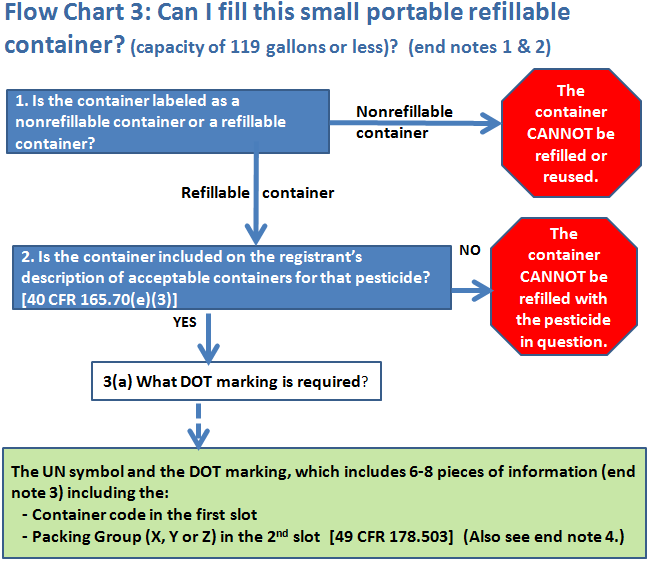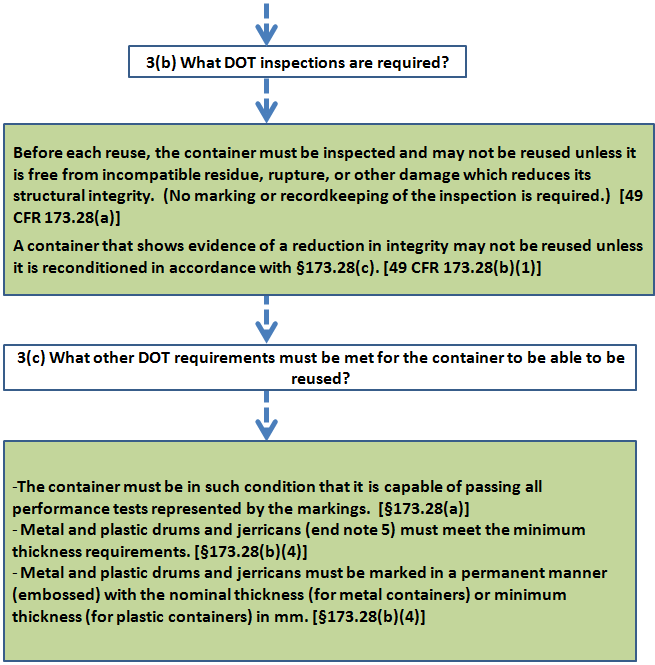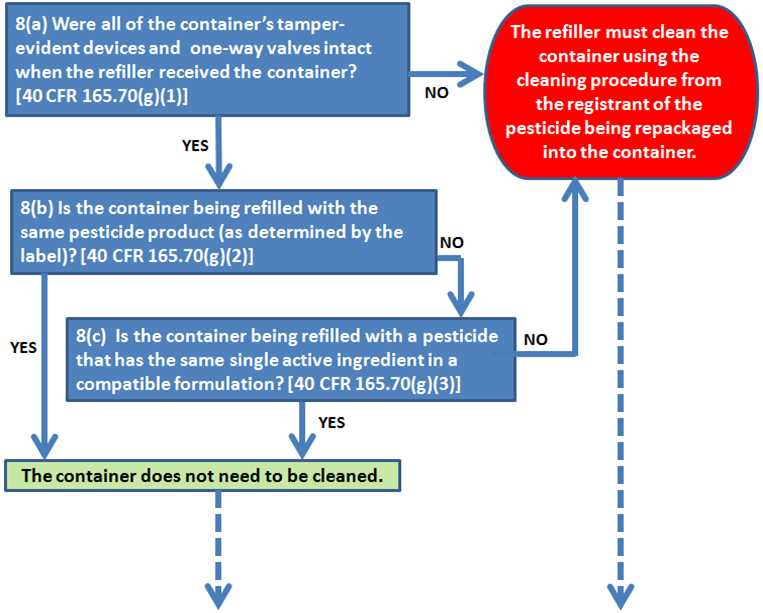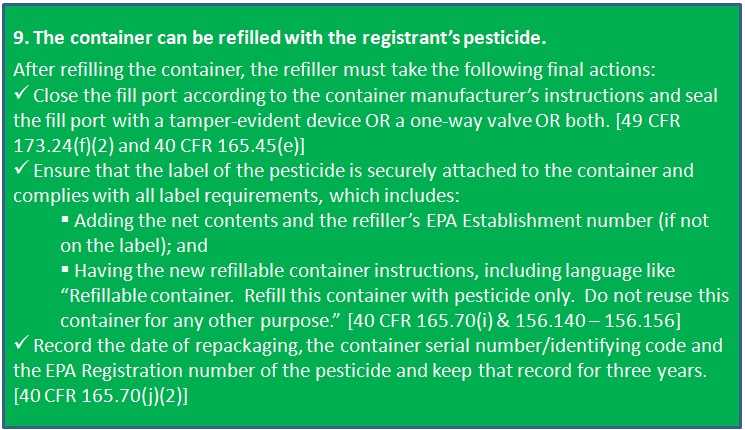




End Notes:
- The volume of 119 gallons is based on the Department of Transportation (DOT) regulations and specifically the cutoff between non-bulk and bulk packagings. This document covers non-bulk packagings. (49 CFR 171.8)
- This flowchart is intended to provide general guidance. See the regulations in 40 CFR Part 165 for complete details. This flow chart is based on the scenario that a refiller at a registered producing establishment (40 CFR Part 167) has a portable refillable container to be filled with a specific pesticide and is trying to determine how to do that in compliance with the refillable container and repackaging regulations. The scenario assumes that: (a) the facility complies with all of the repackaging regulations in 40 CFR 165.60 – 165.70 (such as having entered into a contract with the pesticide’s registrant); (b) the pesticide is subject to the refillable container and repackaging regulations (e.g., it is not a manufacturing use product or an antimicrobial product that meets all of the criteria for exemption); and (c) the container is subject to the refillable container and repackaging regulations because it is being used to sell or distribute the pesticide (e.g., it is not a service container, which is when an applicator transfers a pesticide into the container for the purposes of that applicator applying the pesticide).
- The rest of the information in the DOT marking includes the designation of the specific gravity or mass for which the packaging design type has been tested; the hydrostatic test pressure successfully passed for packagings intended to hold liquids; the last 2 digits of the year of manufacture; the country authorizing allocation of the mark; the name & address or symbol of the container manufacturer; and the nominal or minimum thickness for metal or plastic drums or jerricans intended for reuse or reconditioning. [49 CFR 178.503(a)] Additional information must be marked on reconditioned packagings. [49 CFR 178.503(c)]
- All portable refillable containers that are 119 gallons or smaller must be marked with the UN symbol and DOT marking. EPA’s regulations in 40 CFR 165.45(a)(1) refer to and adopt 49 CFR 173.203 for pesticides that are not DOT hazardous materials, which lists the authorized non-bulk packagings for liquid hazardous materials in Packing Group III. All of the non-bulk containers identified in 49 CFR 173.203 must be designed, tested and marked to comply with DOT’s requirements at the Packing Group III level (at least). In other words, there is no exception for the non-bulk containers like there is for non-DOT Specification portable tanks in the larger size category.
- Jerrican means a metal or plastic packaging of a rectangular or polygonal cross-section. Drum means a flat-ended or convex-ended cylindrical packaging made of metal, fiberboard, plastic, plywood, or other suitable materials. (49 CFR 171.8)
- 49 CFR 173.28(b)(7) includes the following exception to the requirement to leakproofness test before each reuse: Notwithstanding the provisions of paragraph (b)(2) of this section, a packaging otherwise authorized for reuse may be reused without being leakproofness tested with air provided the packaging—
(i) Is refilled with a material which is compatible with the previous lading: (ii) Is refilled and offered for transportation by the original filler; (iii) Is transported in a transport vehicle or freight container under the exclusive use of the refiller of the packaging; and (iv) Is constructed of—
(A) Stainless steel, monel or nickel with a thickness not less than one and one-half times the minimum thickness prescribed in §173.28(b)(4);
(B) Plastic, provided the packaging is not refilled for reuse on a date more than five years from the date of manufacture marked on the packaging in accordance with §178.503(a)(6); or
(C) Another material or thickness when approved under the conditions established by the Associate Administrator for reuse without retesting. - (7) EPA’s regulations (40 CFR 165.45(a)(2)) state that a refiller is not required to comply with the leakproofness test (and associated marking) in 49 CFR 173.28(b) for pesticides that are not DOT hazardous materials if the refillable container complies with EPA’s refillable container regulations and the refilling is done in compliance with EPA’s repackaging regulations.
- The citations for EPA’s repackaging regulations are from the section for “independent” (non-registrant) refillers in §165.70. There are comparable requirements for registrants who are refillers in §165.65.
- You cannot add the UN symbol or DOT marking to a container unless you have the required test data. DOT regulations state that a container “may be marked with the United Nations symbol and other specification markings only if it fully conforms to the requirements of” 49 CFR Part 178. (49 CFR 178.3(b))
- The questions regarding cleaning in #8 assume that the container had previously been used to sell/distribute a pesticide and is received by the refiller with the label of that pesticide still on the container
<
For more information
- See the pesticide container regulations (40 CFR Part 165) or
- EPA’s container web page: https://www.epa.gov/pesticide-worker-safety/pesticide-containers
>
Compiled by Carol Ramsay
